Dark corners and shady beds? We will show you which annual and perennial plants will thrive in your garden without a lot of light.

Many gardeners associate flowers and beautiful plants with sunshine. There are a lot of plants that voluntarily lead a shadowy existence - and not because they are shy or unsightly. In fact, it is a whole series of shade-loving plants that not only green dark corners in the garden, but also look wonderful. Here we share with you 16 great plants that are ideal for shady spots. We have divided the shade lovers into annual and perennial plants.
contents
-
Shade plants: the 8 best annual species for your garden
- 1. Colored nettle
- 2. Pansy
- 3. Lobelia
- 4. Jasmine-flowered nightshade
- 5. Browallia americana
- 6. Point sheet
- 7. Busy Lizzie
- 8. fuchsia
-
Shade plants: the best 8 perennial species for your garden
- 1. Purple bells
- 2. Funkie
- 3. Lungwort
- 4. hellebore
- 5. Astilbe
- 6. Foam bloom
- 7. Forest lily
- 8. crying heart
Shade plants: the 8 best annual species for your garden
Colorful flowers and colored leaves in shady spots? These eight shade-loving, annual plants are wonderfully suitable for making beds without a lot of light a real eye-catcher.
1. Colored nettle
Colorful, colorful, nettle - the colored nettle (Solenostemon scutellarioides) lives up to its name: its brightly colored leaves shine in many different colors from light yellow to red to dark purple. Wild color combinations can also be found with the colored nettle and make it a real eye-catcher. At the same time, it is absolutely easy to care for and does not need much attention, but still enriches the local beds with its colorful leaves. In sunny places, however, the soft, beautiful leaves burn easily, which is why the colored nettle should at least grow in partial shade. The colored nettles also thrive in shady places, but there is one small downer: the darker their location, the less bright their leaves are.
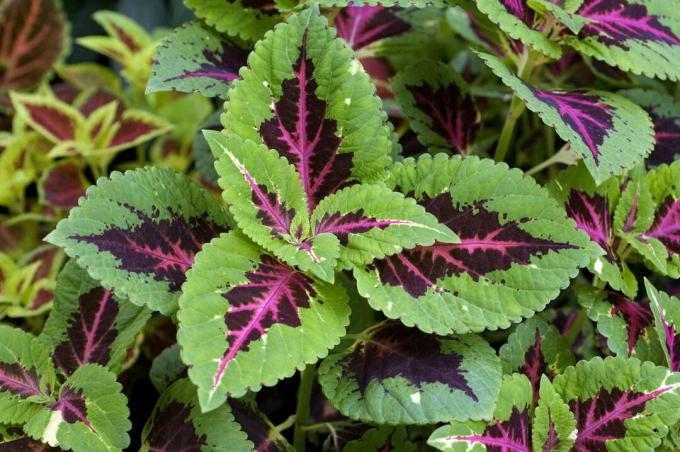
2. Pansy
Not stuffy at all, but beautifully presented Pansy (Viola x wittrockiana) especially in spring. Especially its large flowers, which range in colors from snow-white to yellow to bright Presenting purple in color still makes the plant one of the most popular flowering plants in Germany. But their easy-care nature also makes the pansy so popular - this is how the plant forgives it easy if you tend to “neglect” and don't pay too much attention to them receives. What about the Care of pansies is important, you can find out here. Only the right location is of decisive importance for the small flower: the pansy feels most comfortable in the light shade. If, on the other hand, it is exposed to the blazing sun, it quickly loses its strength and fades.

3. Lobelia
The lobelia (Lobelia erinus), also known as loyal to men, has blossomed into a popular balcony flower in recent years. The reason: The lobelia also grows excellently in shady locations, even if it forms a little more flowers in sunny locations. The lobelia cut a good figure hanging for the hanging basket, but also as an underplanting of tall trunks or even as an upright growing variety. Especially the large number of small, blue-violet, rarely also white flowers, which bloom from May to September, make the lobelia a real feast for the eyes.
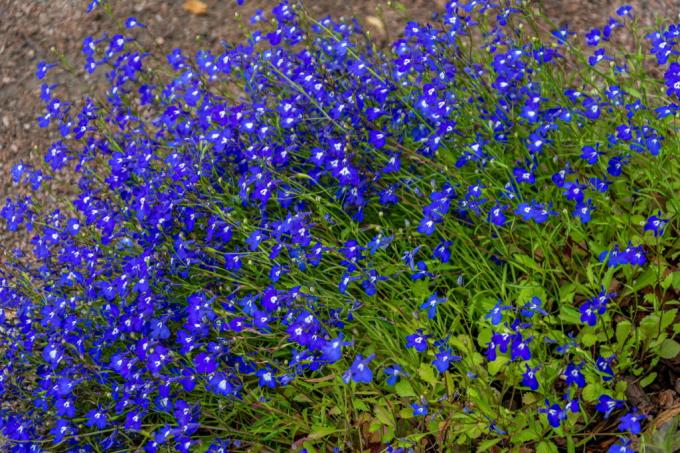
tip: It is particularly important in the shade that you supply your plants with nutrients so that they can develop flowers. You should therefore ensure optimal conditions when planting by using a high-quality organic soil such as our peat-free soil Organic potting soil use.
4. Jasmine-flowered nightshade
Although its name is more reminiscent of the delicate jasmine, the jasmine-flowered nightshade (Solanum laxum), also called summer jasmine, is actually a close relative of the potato and is also called the potato shrub because of the similarity of its large, white flowers. The plant also resembles other nightshade plants in the choice of its location: this is how the jasmine-flowered likes it Nightshade likes to be warm and protected, but not necessarily sunny - the plant also works wonderfully in light shade rightly. The only thing is that the plant cannot tolerate frost at all. It should therefore overwinter in the apartment or be planted as an annual. Otherwise, the jasmine-blossomed nightshade is very robust and easy to care for, only a climbing aid and regular pruning should be Plant - otherwise the climbing plant, which can develop up to ten meters long tendrils, grows quickly over the gardener Head.
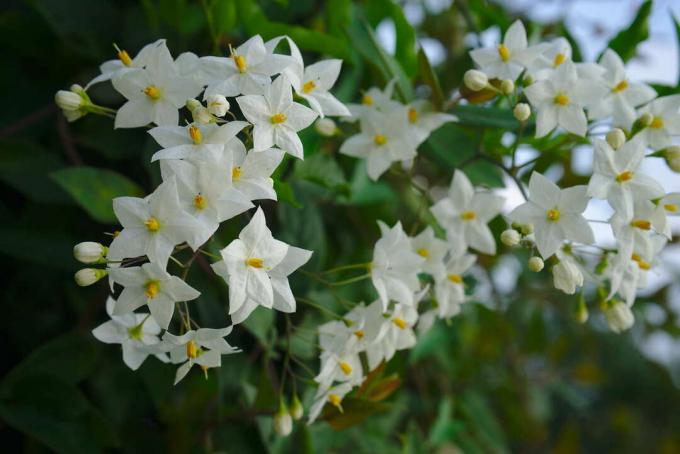
5. Browallia americana
It is hardly known in Germany Browallia americanawhich is why the flower does not have a German name. The plant has a lot to offer and great potential to become a popular summer bloomer: Its light purple flowers appear in July and bloom tirelessly until the first frost. Thanks to its beautiful color, it bears a great resemblance to the forget-me-not, which is why it is also referred to in English as "Jamaican forget-me-not" (Jamaican forget-me-not) will. But their ability to thrive well in shady places also makes them Browallia americana a great plant that turns dark corners into real eye-catchers.

6. Point sheet
No more boring, monochrome plants: the dot leaf (Hypoestes phyllostachya) not only shows its color, but is also characterized by pretty dots on its leaves. Thanks to its pretty white or red color and its interesting pattern, the dot leaf has become an extremely popular houseplant. But it is also a welcome guest in the garden. It proves to be particularly easy to care for and robust, but does not tolerate colder temperatures and is therefore particularly suitable as a potted plant that can be brought into the house as required. The point sheet prefers partially shaded or bright shady locations - if it gets too much light, it can get burned. If, on the other hand, it receives too little light, its foliage color becomes less intense.

7. Busy Lizzie
If you expect a long, beautiful bloom from your plant, you will meet the hardworking Lieschen (Impatiens walleriana) the right decision: The perennial plant blooms from May to October and even increases in abundance over the summer. But it is not only her enormous flowering pleasure, but also the beauty of her flowers, which have an enormous luminosity, that make the hard-working Lieschen a real eye-catcher. The intense color of the flowers even increases in the light shade and creates a colorful light catcher in dark corners. The plant, on the other hand, cannot stand the blazing sun - direct sunlight can burn the sensitive leaves.

8. fuchsia
She is the queen of the shade-loving plants: the fuchsia (Fuchsia) is not only beautiful but also one of the most popular balcony plants around. But it is also a real eye-catcher in the garden and is ideal as an eye-catcher in shady places, as it thrives particularly well even without much light. Contrary to popular belief, the fuchsia is not just a shade plant. Certain suns can also be used Fuchsia varieties well tolerated as long as their environment and their care are tailored to it. Its appearance is also shaped by the diversity of this variety - the fuchsia varies from the small one Fuchsia procumbenswho feels most comfortable in rock gardens, up to Fuchsia excorticatawhich grows into a magnificent tree almost ten meters high. However, all varieties combine the delicate bell-shaped blossoms, which give the flower its special charm. The often two-tone flowers shine in a wide variety of colors and often sit in their hundreds on the branches of the decorative plant.
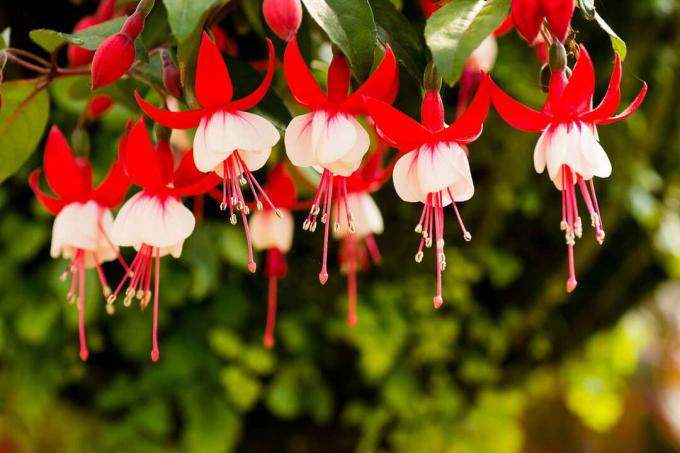
Shade plants: the best 8 perennial species for your garden
Do you want to permanently beautify your shady garden with colorful plants? We'll show you eight perennial, shade-loving plants not to be missed.
1.Purple bells
Tiny bell flowers in white, pink or red - the beauty of the purple bell (Heuchera) can hardly be denied. But the lobed foliage of the plant alone ensures its high ornamental value, after all, it shines in bright colors from green to red to purple and often also wears an elegant one Drawing. The location of the plant is directly related to the color of its leaves: while yellow- and green-leaved varieties shade or If they prefer partial shade, red-leaved varieties should always be in a sunny location so that their leaves have the most intense color possible obtain. However, even yellow and green leaved varieties should not be left completely in the dark, as they often no longer develop flowers when there is too little light. The purple bells usually tolerate a bright, but at the same time shady place very well.
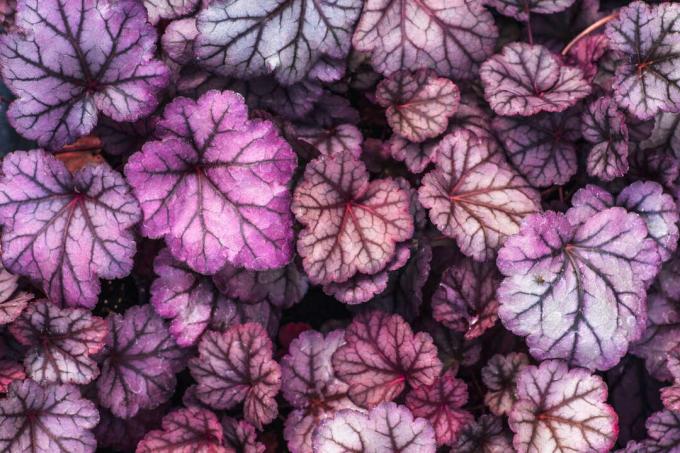
2. Funkie
the Funkie (Hosta) not only impresses with its hanging bluebells, but is also a real eye-catcher because of its unusual leaves: the heart to Column-shaped leaves not only show their colors and appear in creamy white, steel blue or various shades of green, but are mostly also decorative patterned. These properties made the hosta a popular houseplant for a long time. But it can also be cultivated wonderfully in the garden and is almost indispensable for shady forest or Japanese gardens. The funkie is also ideal as a hardy container plant, because it is extremely resistant and robust as long as it is not exposed to the blazing sun.

3. Lungwort
A beautiful carpet of plants that not only impresses with pretty flowers, but also with decorative leaves? That can only do that Lungwort (Pulmonaria) be. With a maximum height of 30 centimeters, this rather small plant is the perfect ground cover for greening shady beds. The lungwort feels particularly at home under deciduous trees or bushes, because here it has in the early spring enough light for abundant flowering, but in summer it is protected from strong sunlight protected. But lungwort also usually gets along well in permanent shade. From March to April the red, purple, blue and (rarely) white flowers appear, which are among the first heralds of spring. Some varieties even change their flower color within the flower, which makes them a very special eye-catcher. But lungwort is not to be despised even after flowering: many varieties have white-spotted or silver-gray leaves, which are also extremely decorative.
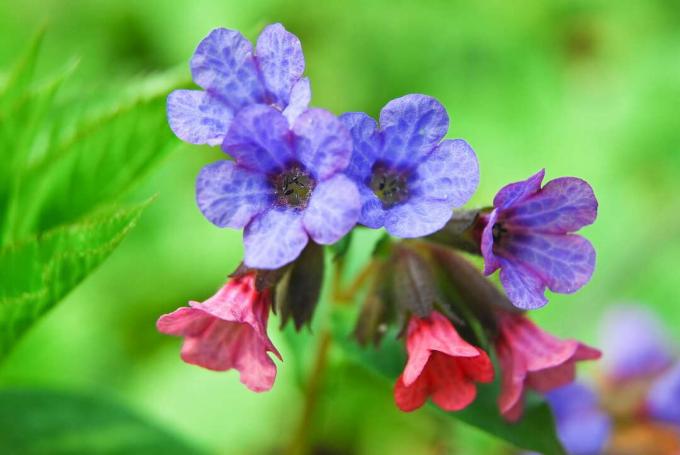
4. hellebore
Hellebore, Christmas rose, spring rose or snow rose: The genus hellebore (Helleborus) has many names and is widespread from Europe to Asia with 15 to 25 species and countless varieties and breeds. This genus is still very popular, especially with gardeners. Last but not least, they bloom early Helleborus-Types of popular garden flowers. The Christmas rose (Helleborus niger), which reliably blooms around Christmas time. The spring roses then bloom between February and April (Helleborus orientalis-Hybrids) and the smelly hellebore (Helleborus foetidus), which gives off a slightly unpleasant odor. Almost all hellebore species are characterized by dark green foliage and beautiful flowers, which make them a real eye-catcher, especially in the snow. Since they also prefer shady places, they are perfect for spring in the shade garden.
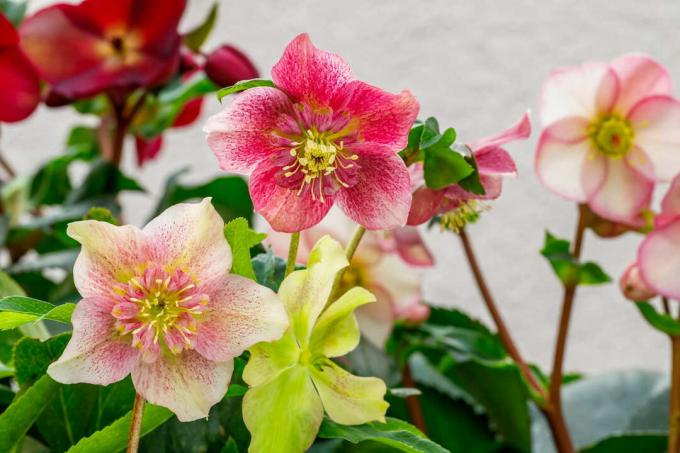
5. Astilbe
Luminous, feather-like panicles of flowers from June to September: Hardly any other perennial blooms as impressively as the astilbe, even in the deepest shade (Astilbe), which is also called splendid spar. The upright plants reach a height of 10 to 100 centimeters, depending on the variety, and bloom in a color spectrum from white to carmine red and purple. But not only the inflorescences beautify the shade garden immensely: If you leave the flowers on the plant, beautiful fruit bunches develop, which also adorn the garden in winter.

6. Foam bloom
They live up to their name: the beds with foam blossoms look almost like the whitecaps of the sea (Tiarella) when they are in full bloom. The countless small flowers in white or pale pink sit in loose clusters on the plant from May to August and create this extraordinary picture. The foam bloom spreads particularly quickly, but only reaches a maximum height of up to 30 centimeters. At the same time, the foam blossom thrives wonderfully in the shade and is extremely easy to care for. For these reasons, it is particularly popular as a decorative ground cover under shrubs and trees. But also in contrast to other flowering shrubs, the foam blossom makes a very good impression and can be used wonderfully to beautify shady beds.

7. Forest lily
Beautiful white flowers and bracts up to ten centimeters in size - the large-flowered forest lily (Trillium grandiflorum) is an absolute eye-catcher. But also other forest lilies (Trillium), colloquially also called three-leaf, are in no way inferior to their big sister: Both the impressive flowers and the three Bracts that protrude almost horizontally from the stem of the plant are found in all species and make them a welcome decoration for the garden. Especially in shady places, preferably as underplanting for deciduous trees, the forest lily feels extremely comfortable and delights us with its majestic sight. But despite its radiant beauty, the forest lily is anything but demanding. On the contrary: once grown, it needs very little care and is very hardy. The plant only needs some water regularly in dry summers, as it does not like drought.
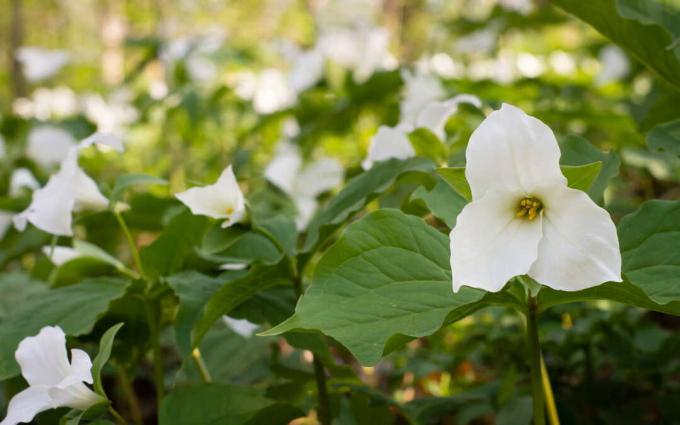
8. crying heart
Easy to care for, romantic, extravagant - the tearful (or flaming) heart (Lamprocapnos spectabilis) is a real beauty in the realm of plants with its unusual flower shape. As the name suggests, with its shape and pink and white color, the flower is reminiscent of a heart, which gives it a very romantic touch. This dreamy charm is further enhanced by the arching overhanging shoots, each of which has a dozen or so flowers. That makes it particularly attractive Bleeding heart However, that the beautiful plant is robust and beginner-friendly at the same time: in a shady, sheltered place the perennial only needs to be fertilized about every two years and only watered on very hot days - more care is not necessary necessary.

Every now and then does a little sun come into your garden? In our special article we provide information about Perennials for partial shade.

